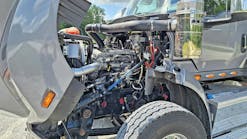The State of Proprietary Diesels
Most American Class 8 truck manufacturers now design, build, and sell their own 11- and 13-liter class heavy-duty diesels, and encourage customers to take them. And Daimler Trucks now has its own line of midrange diesels. Due to continuing customer demand, builders all offer Cummins diesels, usually larger and smaller than what they themselves produce, and describe Cummins as a “valued partner.”
Proprietary diesels make business sense for the builders, and because their engines have generally performed well, customers can benefit, too. Yet as a fleet in Washington state pointed out to us, repairs for the proprietary diesels can only be had at each builder’s dealers, and if the service department is backed up, the truck sits. But most dealers can work on Cummins diesels, which gives customers an alternative that can speed repairs.
Cummins’ latest heavy-duty diesel, the 11.8-liter X12, is due out in the U.S. about now, but the major truck makers have resisted adopting it because it’s too close to what they offer. The X12 claims high output (up to 475 horsepower) and light weight (150 to 400 pounds less than 11-liter proprietary diesels). It seems to have proven itself in China (where it’s been built) and Latin America (where heavy trucks traditionally use smaller engines). It seems ideal for vocational trucks, but so far, only one American truck builder, Autocar, has announced its use, beginning shortly after it enters production this month.
Yet we needn’t feel sorry for Cummins, even if it’s the last independent truck-engine maker. Aside from being a multi-billion-dollar worldwide company that makes power-generation sets and industrial engines, it dominates the North American medium- and light-duty truck-diesel business. For example, Navistar International has discontinued its 5-, 7-, and 9-liter products and instead uses Cummins’ B6.7 and L9 engines. Cummins medium- and medium/heavy products are offered by most other truck builders, as well. And like everyone’s engines, Cummins’ products are not perfect: It recently announced a recall for 500,000 light- and medium-duty 2010- to 2015-model diesels for failures of catalysts that wring out NOx emissions.
Truck builders’ inexorable move toward vertical integration with their own engines and other components pushes North America closer to the practice in Europe and Asia, where buyers think nothing of it. The North American tradition of a manager specifying major and minor components has been fading since the late 20th Century. Some buyers don’t like it, but fewer of them care. After all, mediums and light-duty trucks, not to mention automobiles, have been vertically integrated for many years. Because the latest trucks perform well, the freight, dirt, and concrete is hauled, and everyone makes money.




